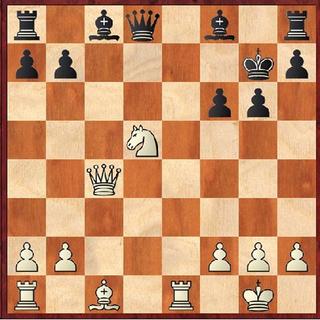White to Play—Advanced Attacking Lesson One
Published in Chess Puzzles

For the next three weeks, we are going to start Pete’s Advanced Course on Attacking Chess. While we have spent a good deal of time on mates in two or three type compositions or real games with mates in two, three or a few more. However, one of the most difficult judgment calls to make for the average player is when and how to initiate a decisive attack if there is no immediate mate in a few moves.
You will get the whole game score. You are encouraged to take out a set and go over it. Stop at the diagrammed position and write down what your possible ideas are, then look at the solution and see if you can imagine it in your head.
If you treat the next three weeks and nine lessons as a chess course, you will improve your standard of play.
Our first lesson in advanced attacking play is a game from 1867, DeVere vs. Steinitz.
It started out this way:
De Vere,Cecil Valentine - Steinitz,William [C67]
Dundee Dundee, 1867
1.e4 e5 2.Nf3 Nc6 3.Bb5 Nf6 4.0–0 Nxe4 5.Re1 Nd6 6.Nxe5 Nxe5 7.Rxe5+ Be7 8.d4 f6 9.Re1 Nxb5 10.Qh5+ g6 11.Qxb5 c6 12.Qb3 d5 13.c4 Kf7 14.Nc3 dxc4 15.Qxc4+ Kg7 16.d5 cxd5 17.Nxd5 Bf8
Solution:
One key to initiating an attack is to expose the enemy king. Another is to get as many of your pieces as you can into the assault. We’ve told you many times that on each move you should look for ALL checks, captures and forced moves. Here, the capture that should jump out at you is 18.Nxf6. Black then has two recaptures with Kxf6 and Qxf6. 18…Kxf6 would be hurt by 19.Qh4+ winning the queen, so you can see that 18…Qxf6 is necessary. What next? You can’t just attack with queen and rook, and developing the bishop to take advantage of the Black queen and king on the same diagonal is your next “obvious” move. All of this can be imagined by looking at the diagram. How about the rest? You should recognize that Black will be desperate to stop Bc3. You should keep the general principal in mind to get all your pieces in the game. That would mean Rac1, with two rooks on open files. Then, getting the rooks to invade on the 7th and 8th ranks is always something to look for. At the end of all this, the bishop ends the game with its move to c3 followed by the rook check on the eighth rank. If you think in terms of concepts and attacking ideas brought up here, the variations will come to you!
18.Nxf6! Qxf6 19.Bd2 b5 20.Qd5 b4 21.Rac1 Qf7 22.Qxa8 Be6 23.Qe4 Bxa2 24.Qe5+ Kg8 25.Rc7 Qd5 26.Qxd5+ Bxd5 27.Re8 Bf7 28.Rxf8+ Kxf8 29.Bxb4+ Kg7 30.Bc3+ Kg8 31.Rc8+ 1–0
Send questions and comments to PTamburro@aol.com.






